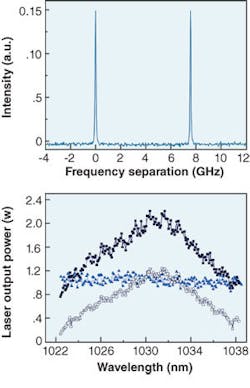SOLID-STATE LASERS: Yb:YAG thin-disk laser is single-frequency tunable
Thin-disk solid-state lasers typically have an excellent beam quality (M2 very close to 1) that is only weakly dependent on pump power. Using Yb:YAG as the laser gain medium in such a laser results in a fairly broad gain range that has considerable potential for applications in spectroscopy such as laser-induced fluorescence (LIF). For LIF, single-mode tuning is desirable. The means for frequency selecting, however, must be carefully thought out because the gain coefficient of Yb:YAG does not allow high losses within the resonator.
A research group at Institut für Physikalische Hochtechnologie (IPHT; Jena, Germany) and Institut für Strahlwerkzeuge (Stuttgart, Germany) has developed a thin-disk laser, pumped by a diode stack emitting at 940 nm, that can be single-frequency tuned along its axial-mode comb from 1022 to 1055 nm.1 Because the mode separation at 1030 nm is only 1.7 pm (0.47 GHz), and each selected mode frequency can be fine-tuned across the free spectral range, each spectral position in the entire wavelength interval can be addressed.
Birefringent crystal
For frequency selection and tuning, the researchers used a combination of a two-stage birefringent crystal and an etalon within the resonator, comparable to Lyot filter tuning of dye lasers. In this work, the birefringent crystal was mounted at the Brewster’s angle to minimize loss of radiation polarized parallel to the plane of incidence. Laser oscillation occurs when losses are low. Using a birefringent crystal as the plate (cut with its optical axis parallel to its surface) results in wavelength selectivity, because the condition for low loss—the polarization lying in the plane of incidence on both sides of the plate—is fulfilled only for wavelengths where the phase difference between the ordinary and extraordinary beams on passage through the crystal amounts to 2p or a multiple.
To narrow selectivity and reject neighboring modes, two crystals of different thickness, 2 and 8 mm in the experiment, were used so that their transmission characteristics multiplied. Final narrowing and fixing to one axial mode was achieved by inserting a 4‑mm-thick etalon. Adjusting and wavelength tuning were performed by rotation of the two-stage crystal around its normal, and by tilting the etalon. Single-mode operation was facilitated by the favorable spatial-mode hole-burning property of the disk laser, in which the gain medium was very close to the resonator end mirror.
A scan was obtained using a Fabry-Perot interferometer with a 7.5-GHz free spectral range and with the laser wavelength set to 1030 nm where gain was maximal (see figure). In this case, the slope efficiency of the system still reached 18.4%, which compares well with 26.3% for the free-running laser. To achieve an almost flat spectral output across the whole tuning range, adjusting the pump power was included into the system control. In this way, almost flat output with about 1-W output was obtained across the entire tuning range.
REFERENCE
1. A. Baum et al., Appl. Phys. B (2005) DOI: 10.1007/s00340-005-2028-6.
About the Author
Uwe Brinkmann
Contributing Editor, Germany
Uwe Brinkmann was Contributing Editor, Germany, for Laser Focus World.
